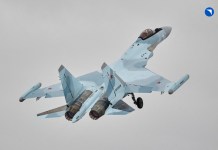Two Russian MiG-31 Foxhound supersonic high altitude interceptor aircraft have made a flight over the North Pole, marking a significant milestone for the country’s navy.
The President of the Russian Federation, Vladimir Putin, was himself briefed about the achievement by the Russian Navy’s Commander-in-Chief, Nikolai Yevmenov.
“Within the framework of an Arctic expedition for the first time ever in the history of Russia’s Navy a pair of MiG-31 jets performed a flight over the North Pole and were refueled in midair,” he informed.

The type was also made operational in the Arctic earlier in December last year when the Pacific Fleet commander Admiral Sergey Avakyants informed that “From December 1, groups of MiG-31 aircraft of the fleet’s naval aviation assumed combat duty in the Arctic.”
The MiG-31 ‘Foxhound’ is a supersonic interceptor strike aircraft developed during Soviet times as a successor to the MiG-25 Foxbat, and shares many design features with the aircraft.
Being one of the fastest jets in the world, it can achieve maximum speeds of up to Mach 2.8 at high altitude, with a cruise speed of Mach 2.3.
The aircraft made its maiden flight in 1975 and was introduced into service in 1981. Since then, it has been constantly upgraded and is the prime delivery platform for one of Russia’s key strategic weapons, the Kinzhal hypersonic nuclear-capable air-launched cruise missile (ALCM).
The Foxhound has made several world records. It reached an absolute maximum altitude of 37,650 meters (123,520 feet) in 1977, and set a time-to-height record of 35,000 meters (115,000 feet) in 4 minutes, 11.78 seconds, both of which were set by the famous MiG test pilot Alexander Fedotov.
Pyotr Ostapenko, his deputy, set a time to height record to 30,000 m (98,000 ft) in 3 minutes and 9.8 seconds in 1975.
On 26 April 2017, a MiG-31 crashed during a training exercise over the Telemba proving ground in Buryatia; both crew members successfully ejected.
While Russian state media did not offer any details, independent investigators discovered from a leaked government document that the aircraft was in fact shot down by an R-33 missile fired from another MiG-31, and that pilot error from both planes were at fault.
The report also suggested problems with the Zaslon-AM radar and Baget-55 fire control system that might increase the risk of more accidental shootdowns occurring in the future.




